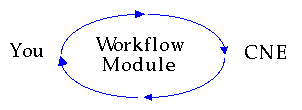
Coordination-based workflow is grounded in the theory of communication and coordination developed by Fernando Flores and Terry Winograd beginning in the late 1970s (Flores 1979, Winograd and Flores 1987). Having proved successful in a series of case studies, this theory is starting to emerge as the basis of the new understanding of work.
In 1979, Fernando Flores offered a new interpretation of communication and the role of computers (Flores 1979). Drawing on the speech-act theory of J. L. Austin (1962) and the theory of commitments by J. Searle (1979), he proposed that most human coordination occurs in the requesting, making, and fulfillment of commitments between people, and he proposed that the importance of the computer lies in facilitating this kind of coordination rather than simply in data processing. The model was further developed in the book with Winograd, where the progress of a coordination was represented as a finite-state machine and called "conversation for action" (Winograd and Flores 1987). In the late 1980s, Flores demonstrated that the basic cycle of coordination reappears at many levels of an organization, not just between individuals, and that the organization itself could be seen as a network of recurring workflow loops. This became the basis of a workflow management system produced and patented by Action Technologies. ( Action Technonogies 1993 , Medina-Mora et al 1992). In an accumulating series of case studies, it has become clear that the workflow-loop map is the basis for measurable and significant improvements in productivity and in satisfaction of customers and employees (Denning 1994, Denning and Medina-Mora 1994). Although the workflow notation was invented for a commercial business context, it is much more general. It can be used to map coordinative processes among humans in any domain.
Figure 1 shows the generic structure of a coordination loop, called workflow by Action Technologies (ATI). The notation supports an interpretation that work is a closed loop process in which a performer completes actions leading to the satisfaction of a customer's or client's request (Denning 1992). During any phase, the participants may make requests of others, thus initiating secondary loops whose completion enables forward progress in the primary loop. This generates a network of connected loops: loop segments can be further refined, fractal-like, into more loops. A human coordinative process is a network of recurrent loops designed to carry out a specific function. An organization can be seen as a network of such processes that collectively carry out the organization's mission.
Figure 2, the map for a procurement process of an organization, illustrates expansion into secondary workflows; in this case, the primary performance phase is expanded into three sequential secondary loops. The figure also illustrates a new notation that shows how client-server computing structure interacts with the business process and affects its performance. In a case study at George Mason University, we found that the process of student advising cannot be made to have a fast turnaround unless the transcripts of individual students are available on a moment's notice to a faculty advisor during an advising session; to achieve the required response time, the database must be mounted on a local server (Denning and Medina-Mora 1994).
The power of this notation derives from two complementary aspects. First it explicitly shows the actions leading to the satisfaction of an agreement between two parties. Second, it shows direct connections between incompletions of loops and breakdowns such as persistently dissatisfied customers, wasted effort in complaint loops, lack of trust, or poor market credibility. Figure 3 shows how a persistent incompletion in the primary loop of a procurement process can give rise to a new secondary loop for complaint resolution, which can further delay customer satisfaction and unnecessary load to supporting computing servers. Case studies show that organizations that persistently complete their loops on time will have many fewer of these problems. Business process re-engineering can be significantly facilitated with workflow-map notation that shows both the business process and client-server computing systems (Denning and Medina-Mora, 1994).
The workflow map is explicitly concerned with the making and fulfilling of commitments, with determining who is responsible to carry out the work and by when, and with the satisfaction of the person making a request. These concerns place the organizational processes at a higher level of abstraction than the business, materiel and information processes of an organization -- the latter being the processes that move physical items and information items to various places where they are manipulated and combined. The more general organizational processes drive materiel and information processes. For this reason, tools for observing, measuring, and modeling material and information processes -- e.g., IDEF1 and Queueing Network Models -- are not powerful enough for building workflow systems oriented towards all organizational processes.

On to Advanced Workflow Topics
Back to the Workflow Module Map

MRH
9/27/94